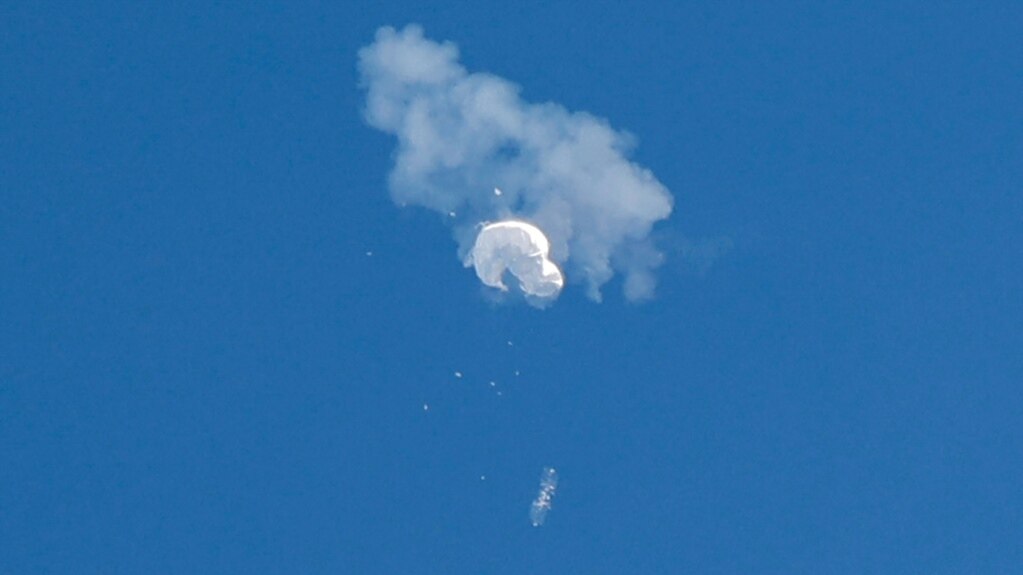Last week, the United States said a balloon shot down by the U.S. military was part of a major international spying operation led by China.
The balloon was shot down February 4 over the Atlantic Ocean off the coast of South Carolina. By that time, the balloon had moved across the United States. During its trip, the balloon was observed flying over several Air Force Bases, including one in Montana that stores U.S. nuclear weapons.
U.S. officials have repeatedly stated they believe China purposefully flew the balloon into U.S. airspace and that the airship had the ability to carry out spying activities.
China has said the balloon was an unmanned weather airship that got blown off its path by wind and ended up going into American airspace. Chinese officials have accused the U.S. of overreacting by shooting the balloon down with a missile fired from an F-22 fighter plane.
Since the downing of that balloon, U.S. military jets have also shot down three other unidentified objects found moving across American and Canadian territory. National Security Council spokesman John Kirby said last week that while those three objects were not confirmed to be spy balloons, the U.S. “couldn’t rule out” that possibility.
Kirby added that the U.S. decided to take out the three other high-flying objects “out of an abundance of caution” because they might have presented a risk to civilian planes in the area.
U.S. officials have suggested that such balloons have “limited additive capabilities” compared to China's other intelligence gathering programs.
So how effective are air balloons at carrying out spying activities? Experts say such efforts might seem low-tech compared to satellites and other intelligence-gathering methods. But they can be useful instruments if they are equipped with the right technology tools.
History of spy balloons
Historically, high-flying balloons have often been used for spying and military activities.
During World War II, Japan’s military dropped bombs into U.S. territory using balloons designed to float in jet stream air currents. No military targets were damaged by the balloons. But several civilians were killed when one of the balloons crashed in a forest in the northwestern state of Oregon.
Just after World War II, the U.S. military started exploring the use of deployed spy balloons. This led to a series of operations called Project Genetrix. U.S. government documents suggest the project flew photographic balloons over Soviet Union-supported territory in the 1950s.
How high do they fly?
Spy balloons generally operate at 24,000-37,000 meters, well above where civilian air traffic flies. Passenger airliners rarely fly higher than 12,000 meters.
Balloons vs. satellites
A 2009 report to the U.S. Air Force's Air Command and Staff College said one advantage of balloons over satellites is the ability to observe wide areas of territory at closer distances. Balloons are also able to spend a longer time over target areas, the report said.
Experts have also noted that balloons do not cost a lot of money to deploy. Satellites, on the other hand, require complex space launch systems that can cost hundreds of millions of dollars.
AI powered?
William Kim is an expert in intelligence balloons at the Marathon Initiative policy center in Washington D.C. He told the French news agency AFP that balloons are valuable observation tools that are difficult to shoot down.
Kim said the Chinese balloon shot down by the U.S. was likely a normal weather balloon with some added technology. Images of the balloon showed that it was solar powered and appeared to have electronics, guidance and data collecting abilities, he added.
Kim said he believes the balloon was powered by artificial intelligence (AI) technology. This would enable it to guide itself based on air changes in the atmosphere. "Before you either had to have a tether... or you just send it up and it just goes wherever the wind takes it," Kim said.
Another possible advantage of balloons over satellites is that they are difficult to find with traditional radar equipment. "These are materials that don't reflect, they're not metal,” Kim said. “So even though these balloons expand to quite large, detecting... the balloon itself is going to be a problem," he added.
I’m Bryan Lynn.

